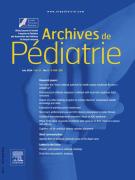Weaning from noninvasive ventilatory support in infants with severe bronchiolitis: An observational study - 28/04/23
 , C. Freycon a, J. Doutau b, I. Pin a, A. Bellier c, B. Fauroux d, e, G. Mortamet f, g
, C. Freycon a, J. Doutau b, I. Pin a, A. Bellier c, B. Fauroux d, e, G. Mortamet f, gAbstract |
Background |
The aim of the study was to analyze the weaning success, the type of weaning procedures, and weaning duration in consecutive infants hospitalized in a pediatric intensive care unit over a winter season.
Methods |
A retrospective observational study was conducted in a pediatric intensive care unit in a tertiary center. Infants hospitalized for severe bronchiolitis were included and the weaning procedure from continuous positive airway pressure (CPAP), noninvasive ventilation (NIV), or high-flow nasal cannula (HFNC) was analyzed.
Results |
Data from 95 infants (median age, 47 days) were analyzed. On admission, 26 (27%), 46 (49%), and 23 (24%) infants were supported with CPAP, NIV, and HFNC, respectively. Weaning failed in one (4%), nine (20%), and one (4%) infants while supported with CPAP, NIV, or HFNC, respectively (p = 0.1). In infants supported with CPAP, CPAP was stopped directly in five patients (19%) while HFNC was used as an intermediate ventilatory support in 21 (81%). The duration of weaning was shorter for HFNC (17 h, [IQR: 0–26]) than for CPAP (24 h, [14–40]) and NIV (28 h, [19–49]) (p < 0.01).
Conclusions |
The weaning phase corresponds to a large proportion of noninvasive ventilatory support duration in infants with bronchiolitis. The weaning procedure following a “step-down” strategy may lead to an increase in the duration of weaning.
Le texte complet de cet article est disponible en PDF.Keywords : Infant, Weaning, Critically ill children, Acute respiratory failure, Mechanical ventilation
Plan
Vol 30 - N° 4
P. 201-205 - mai 2023 Retour au numéroBienvenue sur EM-consulte, la référence des professionnels de santé.
L’accès au texte intégral de cet article nécessite un abonnement.
Déjà abonné à cette revue ?

